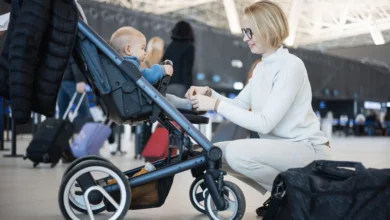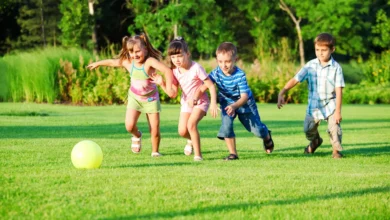One day, I made him wear a backpack at the airport. Even though I tried to act like it was “just a bag”, I could not help but feel the judgmental gazes as I walked him towards the exit gates.
It’s true that toddler leashes and harnesses, or anything else that tethers the child to its parents, are controversial. I can understand it. However, there are some positives to using them safely and positively. Here are a few pros and cons of this highly controversial parenting product.
Let’s Face It, Toddlers Are a Lot Like Puppies
I know that putting your child on a leash can make him appear – or even feel like a dog you cannot trust. Toddlers can be unpredictable, and lacking in judgment and risk assessment (don’t run toward that ledge!). They have also been known to drink from the water bowl of the dog at an outdoor cafe. Just saying.
They Are Also Not!
Toddlers want to be independent. It may be a disservice to them if you restrict their freedom to explore and make mistakes.
If you have a group of children to protect, a child with a disability who makes it difficult to carry (holds up hand), a toddler who refuses to ride in a jogging stroller, or a runaway toddler that simply cannot be trusted to hold Mummy’s hands (also holds up hand), then is well worth considering.
We’ll only cover the two we know about. There are others, like wrist tethers, which aren’t recommended because they can be dangerous.

The Pros
There are many benefits to using a backpack or toddler harness with a leash.
- Keep your baby close to you and away from danger.
- You may find that your toddler enjoys the sense of security and autonomy she gets from being able to walk a short distance by herself.
- You can let your toddler carry all her stuff with a backpack that is themed after an animal. It just so happens it has a leash.
- The harness is compact and can be stored in your diaper bag. It will only need to be pulled out when necessary.
- You can buy them cheaply at stores.
- When you are out with your unpredictable and emotional child, you might feel less anxiety.
Cons
- Restricted your child’s freedom. She is not allowed to explore the world and develop her awareness of danger.
- You make her feel that you do not trust her
- It looks like you are walking your dog, not your child
- You will be judged by others.
- The harness or backpack may be a big problem for your toddler. They might hate it and make it a lot of trouble.
- It may be a game for your toddler to run and try to escape from the backpack.
It is important to consider how you will use the leash.

You may find that your child is more willing to wear the harness or backpack if you do not imply to her that you do not trust her. Instead, you want to protect her. If you limit its use to walking in car parks or near busy roads, your child may perceive it as more of a safety measure than a restriction.
What about me? After that awful airport experience, I never used my monkey leash bag again. I felt judged. I would never judge a parent who has a toddler who is running away if they use one. They are also trying to protect their unpredictable child.
You’ve been there and done that. I’m so glad that my days of running away are over!
Toddler Harnesses – Tried in Court of Public Opinion
Parents often use toddler harnesses in malls or public places. The harness is a backpack that has a removable “leash” for the parent to hold. Some people find them useful, while others see them as a lazy and demeaning substitute to holding a child’s hand. Some reports have expressed concern that parents could become oblivious of their surroundings and increase the risk of abduction by a predator if the ‘leash’ is cut.
Due to the controversy that surrounded the harnesses, I was reluctant to purchase them. With four toddlers of the same age, we stand out already. I didn’t want to stir up controversy and hear the comments of parents who were outraged or misinformed. My husband wanted to buy them for some time, but I wasn’t ready to deal with the controversy.
Since the quad stroller broke, I haven’t taken Sugar Snaps anywhere by myself (unless I am in a store where I can place them in my shopping cart). I took them to a park near me that has a playground. It was enough to keep them on the path leading to and away from the playground. It sounded easy enough, so I tried it. The children were very cooperative on the walk from my car to the play area, which was located at the bottom of the hill. A path led to the park. I held their hands while the two others held hands in front of me. It was a smooth operation.
The playground was a good place for them to play, as there were just two toddlers and two grandmothers. I began to feel confident about taking the Sugar Snaps places on my own and keeping them safe. After we had given them enough warnings, the time came to leave. It was time to leave, and two of them were happy to do so. If He had been there, we could have used strollers and gotten rid of the protestors. I held their hands instead (the two who were protesting), and the two others walked together up the hill to the car. I opened the doors of the car, and they sat together in the grass beside the car.
Then it happened. Before I could stop them, two of my children ran down the hill at full speed. One was in a car, and the other was on the lawn. One was in the car and one was on the lawn. I knew instinctively that the one on the grass would not run, so I ran after them both while glancing back and forth. My heart was pounding as I caught up with them and quickly walked them back up the hill to the other two. My mind raced with all the horrible things that could have occurred as I told the runners to “never repeat that.”
While I was driving home, adrenaline rushed through my veins. As I sat them down, the enormity of what could have occurred hit me. He was in tears when I told him that I would never take them anywhere without a cart again. He gently reminded me that harnesses were an option, and my answer was not correct. He picked up animal “backpacks” that were two dogs and two monkeys as our trip to Disneyland neared.
The monkeys and the dogs were instantly their favorites and they couldn’t wait for them to go on a walk. Some people preferred that he not hold their hands. He liked to keep them safe. Harnesses are compared to leashes by critics who argue that they do not provide safety. They are used for safety just like strollers and car seats. Stereotypes are to blame for the misconceptions surrounding harnesses. Toddlers enjoy them. It is better to use harnesses than risk the safety of a child.

I used them for the first time at Disneyland. Had to lift two strollers on the shuttle, while I was able to load all four by myself. I was able to safely do this with the harnesses. They were also useful while we waited in line to ride. We waited in the sun for 15 to 20 minutes, and the kids were too squirmy and hesitant to hold hands. They were also tempted to duck underneath the railings. We were able to keep the children safe with harnesses. As an adult, it is impossible to watch all the toddlers while ducking under the railings. This is our first (and likely not our last!) negative comment.
The woman who was in line behind her daughter called toddler harnesses “leashes.” I chose to remain silent to protect my daughter, knowing that it was not right to correct her in front of her child. While it may be tempting to put comfort above appearance, the safety of our children comes first. What do you think about this? We welcome your thoughts.
Conclusion
The child leash has been a source of disagreement between parents and caregivers.
Many leash users report feeling judged by adults, whether they do so directly or in silence. It’s possible that you, as an early childhood educator or parent, have been on both sides of this judgment. The leash is useful in some situations.
Each child grows at his or her own pace. You can’t tell the full story of a child-adult relationship from a glance at a mall or sidewalk. Maybe the child has sensory issues and is uncomfortable with physical contact. Perhaps the adult has mobility issues, and the leash will help them stay near the child when out in public.



